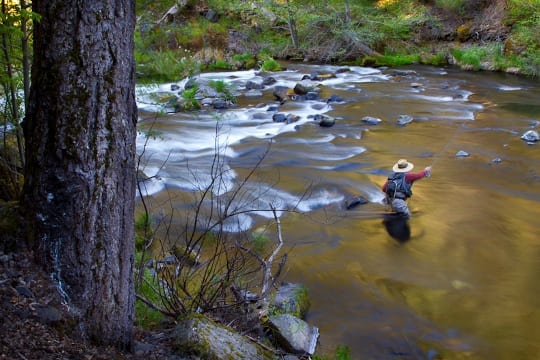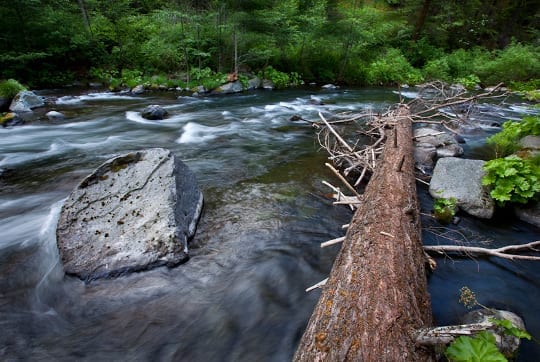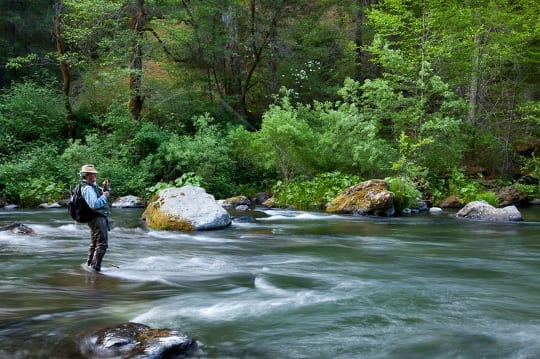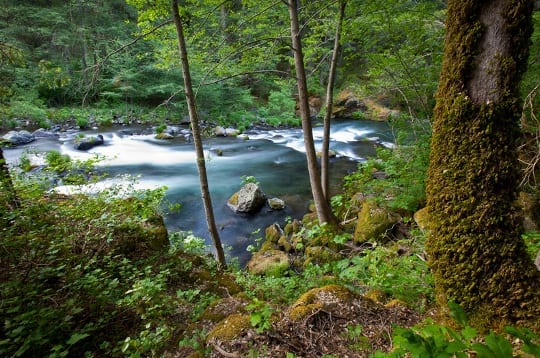Keith Brauneis Interview: We Talk To The Filmmaker Behind “Enough is Enough”
The maker of the McCloud “Enough is Enough” video talks about rivers, cameras, and nearly freezing to death.
Keith Brauneis is the creator of the McCloud River documentary titled Enough is Enough. He’s a California photographer who spent most of his career shooting commercial still photography. It was good work, but a nagging desire to tell stories eventually led him down a different path.
Fast-forward to the present day, where Brauneis just completed Enough is Enough — a short documentary video about California’s McCloud River and the threats facing it. Supported by CalTrout, the video will be seen in the California showings of the Fly Fishing Film Tour (the trailer is available below; you can watch a larger version here).
Enough Is Enough Trailer from Keith Brauneis on Vimeo.
Last week we talked to Keith about the making of Enough is Enough. Here’s the best bits. Enjoy!
Tell me how the movie Enough is Enough came about.
I was having lunch with Jeff Thompson (ED: California Trout’s Executive Director), and he said they wanted to make great short film about the McCloud — a thoughtful documentary that would also appeal to the Fly Fishing Film Tour crowd.
I said I wanted to make a really good environmental film that didn’t come across as dry. I think we found a nice balance with Enough is Enough, which is about something unique and precious — that we’re in danger of losing.
Within six weeks we were up there filming away, starting to chisel out the story — figuring out what story needed to be told.
When did Enough is Enough emerge as a theme?
We tossed around a lot of ideas, and a lot of them — in retrospect — were lofty and pretentious.
Then Craig Ballenger used the phrase in his interview, and it stuck. The McCloud’s facing a lot of challenges and has suffered a lot of indignities, and it seems like it’s done enough.
Anything specific?
The thing that really blew my mind was the million sq. ft. bottling plant that Nestle wanted to build. That’s huge.
I had no sense of scale for something like that, so I did some research. That’s bigger than AT&T Park (ED: Where the SF Giants play).

The McCloud River (image courtesy Keith Brauneis)
Talk to me about your history with the McCloud.
I’ve been as passionate about fly fishing about as long I’ve been passionate about photography — about the age of 16. Those two passions have been hand in hand.
It wasn’t until I was 35 or 36 years old that I wondered if there wasn’t a way to make a living combining these two passions. I built takethefly.com and started showcasing my fly fishing stills.
You know how it is; you put those things out there in the world and things start moving in that direction. Shortly thereafter I got a call that Leland’s Outfitters was looking for a creative director.
For about two years I created still and video content for them. I was able to shoot, produce and showcase a lot of really good, fun work.
So you’ve been a fly fisherman a long time; what’s your relationship with the McCloud?
I’ve been there a handful of times; like anybody, the first time I saw the McCloud it was more a feeling than a sight. There’s so much history — it’s hard not to feel the spirit of the place.
People’s reactions to the McCloud are often more visceral than verbal.
Yeah. You feel that river. You just feel it. There’s something going on there.
I hear the same things about the entire Shasta area — a feeling you don’t get in other parts of California.
When you were filming, you saw a chunk of the river most people never see.
One day we put in a mile above Big Springs (ED: the Upper McCloud, above McCloud Reservoir) and floated all the way down through the Hearst Property — something not many people get to see.
Basically, I saw everything from there to down below the Nature Conservancy property. A lot of river.
A lot of beautiful river.

(Image courtesy Keith Brauneis)
But instead of fishing the river, you were in a boat with a video camera in your hand. How did it change for you?
It’s the first time I really experienced the McCloud. The first time I felt enveloped by the river. We slept on the ground, we fished, we floated, we walked. It affected me. It really affected me.
I hope that comes through in the film.
When you really get to spend time with a river like that, it’s a special thing.
So approximately how many days were spent on the river?
When it was all said and done, about ten days of filming.
What about the heavy lifting — the production?
It was my first short — the longest film I’d ever produced and edited myself. I wanted to do it right so I really took my time. I took me about three months to edit it.
At times, I’d edit a chunk and then I’d really sit with it.
You know how it goes; you just rework something until you’re blue in the face.
Any funny stories related to the making of the movie?
That I want to talk about?
What happens on the McCloud stays on the McCloud?!
[laughing] I think someone said that.
We were really focused on the work. One night we wanted to float through Big Springs and come out on the reservoir. Curtis Knight’s plan was to float the Upper McCloud, then meet a boat on the reservoir and sip a cold beer while being towed across the reservoir to the launch ramp.
He hadn’t counted on me insisting we wait for the sun to set before we left Big Springs. So after rafting down the river we were soaked through to the skin; I was freezing and borderline hypothermic. And all this before we found ourselves being towed across the reservoir, where the wind was howling.
When we finally got to the ramp — and it seemed like forever — we all ran to the trucks.
I don’t know if that was funny or not, but it was memorable. It was the kind of thing you could look back on and think it was funny, but at the time, you’re getting concerned that things are about to develop into a situation.
Tell us a little about your background as a filmmaker.
I started as a fine art photographer in my late teens; I went to the Brooks Institute in 1994 and graduated, and for the next 15 years, I mostly shot advertising photography. It was a good living and I enjoy it, but in the last four years I started making films.
Just the last four years? Why the switch to video?
It started when a client asked me to direct a spot for the Oakland Raiders. From there I was asked to direct another spot for University of San Francisco. Pretty quickly, this type of storytelling started to appeal to me. I went from shooting single frames to stringing images together to make a story. It was freeing.
For the last few years, I’ve been doing mostly video work. I’m having so much fun now with the filmmaking it’s taken a front seat.
Is this your first self-produced movie?
This is the first movie I produced, directed, photographed and edited. I was the director of photography (DP) on a film called Eat The Sun, which was about people who stare at the sun for health purposes.
They stare at the Sun?
You can Google it. It’s real.
But this is my first crack at a short film — a documentary really — where I pulled out all the tools in my bag. I can say I liked the experience. I can say that.

Craig Ballenger on the McCloud (image courtesy Keith Brauneis)
How did it feel to be a one-man band?
You’re never a one-man band really, there are a slew of folks on both sides of the camera that bring films to life. I’ve been shooting Canon SLR cameras for the last decade, then the Canon 5D came out and I was just blown away by the camera. The next iteration was the 5D Mk 1, which could also shoot video.
I was in love.
Suddenly filmmakers could create quality videos with an SLR — and an SLR in my hands is like a basketball in Larry Bird’s hands. It just feels right. I never thought I’d like to haul around one of those shoulder-mounted video cameras, and suddenly, I didn’t have to.
A lot of traditional DPs and producers said it was a toy, but time has proven them wrong. I’ve seen some amazing stuff produced with one of these.
Some truly spectacular work has come out of those cameras.
Many shorts, indie films, music videos and personal projects are being created on this camera. It’s opened so many doors.
OK, so you’re a first-time moviemaker: Did you suffer any bottlenecks or a steep learning curve?
It was the first time I wasn’t standing over anyone’s shoulder telling them to move things. I had to learn to do everything myself — which has its costs — but with those costs came a lot of freedom.
In truth, I loved it.
So in the end, the only real bottleneck was me. The desire to make this piece for the McCloud River and CalTrout kept me up at nights.
While we’re talking about it, what equipment was used to make the movie?
The cameras we used were the Canon 7D and Canon 5D Mk II. For lenses I used your basic 16-35 and 24-105, 24-70 and 70-200. I found those were a lot easier to use on a location than prime lenses.
When you’re cruising down a river on the back of a raft, you don’t have time for do-overs, and you risk your camera to the river every time you change a lens. Believe me, a zoom was better.
It was edited on Final Cut Pro 10 — the newest version — on a relatively new 27″ iMac.
Not everyone loved the “upgrade” to Final Cut.
A lot of people complained that they over-simplified the software, but I’m into simplicity.
What role did CalTrout play in the movie?
A huge role. They were there every step of the way, including funding. And Craig Ballenger played the role of art director.
And all-around crazy river guy.
Yeah, that too. He knows these rivers like the back of his hand. I’d tell him what I wanted — I’d say “I need the sun setting with the pool facing this way with the water doing this” — and he’d say “OK, let’s go here.”
And we’d get there, an inevitably it was just what he said it was.
Curtis Knight was a great help. He rowed the raft and explained the finer points of the Nestle issue, FERC relicensing and dam raising. And this was pretty clearly Jeff Thompson’s vision.
Basically, every day I was there, CalTrout was there too.
Any bad patches during the making of the movie?
There were times during the project that I questioned my own abilities. There comes a time when the artist inside me doubts himself, when I don’t believe I’m being as creative as I can be.
That’s the kick I give myself — what can I do to be more creative?
I think that crops up on every project. Nobody’s inside your head, and there comes a point in every project where all the plates drop, and you’re standing there looking at all the pieces on the ground and wondering how to get them picked up and spinning again.

(Image courtesy Keith Brauneis)
What’s next?
This project has confirmed for me that this is the path I want to be on — the path of the storyteller.
So making this movie has shifted you a bit?
Yeah, I’m going gangbusters now. The floodgates are open. I’m already looking forward to the next project.
Any last words about the McCloud?
Not really. Well, yeah, watch the movie. There are always different approaches to take to save a river, and we’re all trying to save the McCloud.
Our interests may be different, but we’re all trying to save the river.





10 Comments
This Keith Brauneis cat has got real soul and it shows on the film “Enough Is Enough.” Sometimes it takes simple genius to strip it all down and look at the fact that “Enough is Enough.” Every single piece of trout habitat on earth is being heavily impacted by man. Whether that be dams, deforestation, over fishing, development, roads, de-watering and on and on. Enough Is Enough. Good Work Cal-Trout and good work, Mr. Brauneis.
Keith, is that you?
Seriously, thanks for taking the time to comment. If you read the interview, you know the effect the McCloud had on Keith (which is about the same effect it has on most people).
We’re proud of the movie, and hope to feature the full-length version eventually right here on the site.
As a member of the Bollibokka Club, I welcome this movie and hope it succeeds in protecting this incredible river for all time. If the Shasta Dam is raised, most of the canyon that is now the Bollibokka will be flooded. We are talking about one of the most scenic rivers in the world, there is no other place like it in California and we must protect it at all costs. The key to preserving our natural resources in California is population control. The Sierra Club was right even though they got a lot of grief for it. The thirst for water is directly tied to our growing numbers and our lack of awareness of the impacts of over 36 million people.
Frank,
You know Bollibokka is owned by Westlands Water Mgt, yes?
I knew it was out of the Hills family now and thought it was owned by PGE. I thought PGE bought up all the land they want to flood….
The Bollibokka is owned by Westlands, who bought it to remove a potential obstacle to raising Shasta Dam. They feared that someone would buy the property and develop it. If the dam is raised, the land they bought will be bought from them by the feds, and they’ll receive more water deliveries, which will either go to irrigation or be sold at a very high price.
PG&E is in fact concerned about the Shasta Dam raise because it would impact their Pit 7 powerhouse limiting the amount of power they can generate.
Dear Cal Trout staffer…A while back I sent CalTrout an email asking your group to take a look at some technology a man in Nipomo has invented that he wants to give to conservationists and the Fish and Game to increase the yield and survivability of natural spawning trout from the current 8% to over 80%. No one responded. This is not about making money or anything like that at all. This man has created a spawning system that can be placed in the stream that increases the amount of eggs that mature by tenfold. He wants to give it away to folks like you. The Fish and Game have been over there to check it out and liked it but it needs to go through some hurdles before they can use it. Can you get someone down here to get in touch with me and I will send you his number? BTW, he also created a complete fish hatchery on his farm and has raised over 7000 perfect diploid trout. You guys need to meet him, he is an incredible person.
Thank you, I’ll pass it along, but CalTrout probably couldn’t use something like this until Fish & Wildlife had tried it.
I was talking to Chris Keig of the FF Film event in Sac this year. He said you were the sponsors of this event along with FF Specialties. We would be interested in sponsoring an event in the Roseville area and wondered if we might talk about partnering up on doing this.
Tom Bartos
916-205-6073